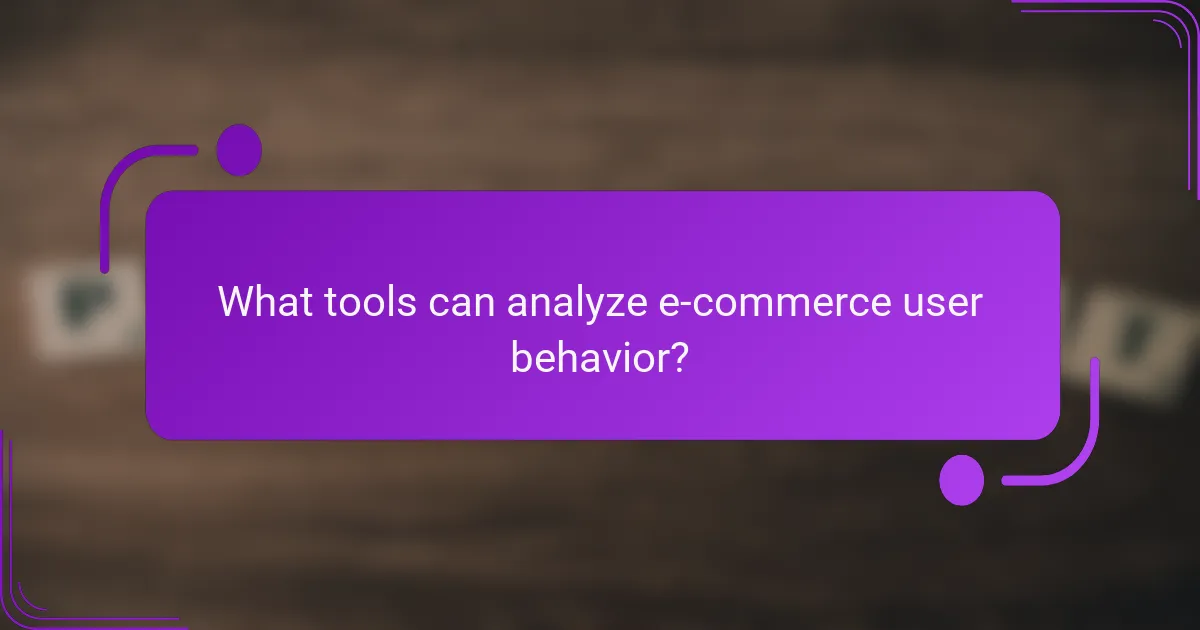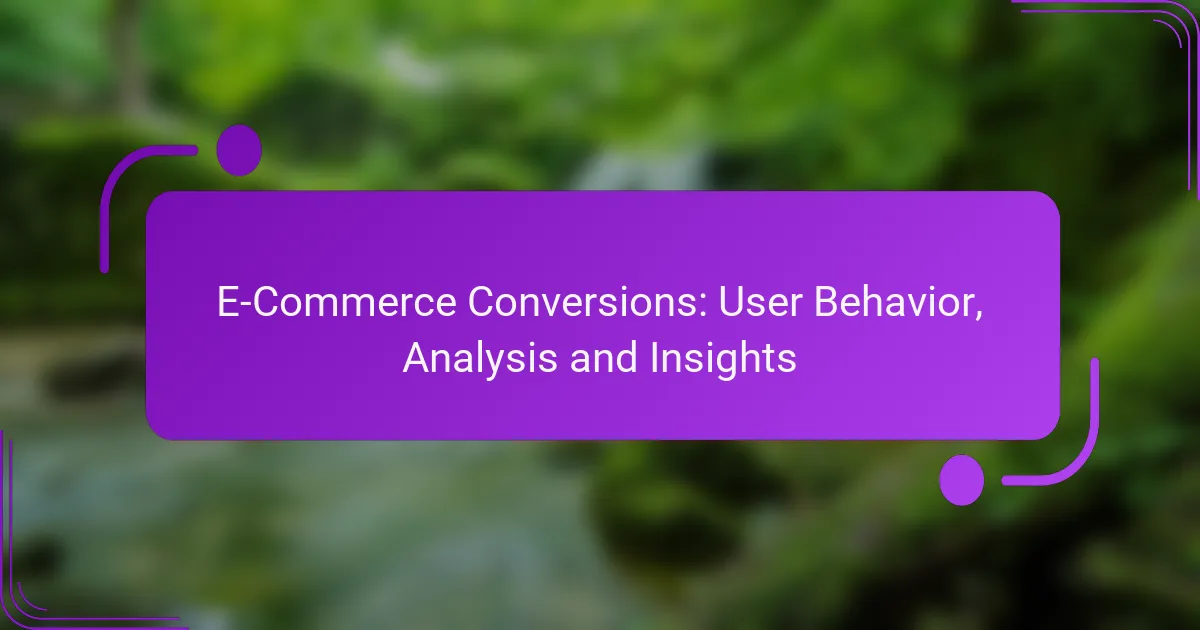In the competitive landscape of e-commerce, understanding user behavior is crucial for driving conversions and enhancing overall performance. By analyzing factors such as website design, pricing strategies, and customer feedback, businesses can tailor their online presence to meet consumer needs. Implementing targeted marketing techniques and utilizing analytical tools can further optimize the shopping experience, leading to increased sales and customer satisfaction.

How can e-commerce businesses improve conversions?
E-commerce businesses can enhance conversions by focusing on user experience, optimizing website elements, and employing targeted marketing strategies. Implementing effective techniques such as A/B testing, improving loading speed, and personalizing customer interactions can significantly boost sales and customer satisfaction.
Implement A/B testing strategies
A/B testing involves comparing two versions of a webpage to determine which one performs better in terms of conversions. By testing different elements such as headlines, images, and call-to-action buttons, businesses can identify what resonates most with their audience.
To effectively implement A/B testing, start with a clear hypothesis and test one variable at a time. Tools like Google Optimize or Optimizely can facilitate this process. Aim for a sample size that provides statistically significant results, typically in the hundreds or thousands of visitors.
Optimize website loading speed
Website loading speed is crucial for retaining visitors and improving conversions. Studies show that even a one-second delay can lead to a significant drop in user engagement. Aim for a loading time of under three seconds to keep potential customers interested.
To enhance loading speed, compress images, minimize HTTP requests, and leverage browser caching. Tools like GTmetrix or Google PageSpeed Insights can help identify areas for improvement. Regularly monitor performance to ensure optimal user experience.
Enhance product descriptions
Well-crafted product descriptions can significantly influence purchasing decisions. They should be clear, concise, and highlight key features and benefits. Use engaging language that resonates with your target audience to create a connection.
Incorporate bullet points for easy readability and include relevant keywords for SEO. Consider adding customer reviews or testimonials to build trust and provide social proof. Aim for descriptions that are around 100-200 words, balancing detail with brevity.
Utilize personalized marketing
Personalized marketing tailors content and offers to individual customer preferences, enhancing engagement and conversion rates. By analyzing user behavior and purchase history, businesses can deliver targeted emails, product recommendations, and promotions that resonate with specific segments.
Utilize tools like email marketing platforms or CRM systems to gather data and create personalized experiences. Ensure compliance with data protection regulations, such as GDPR, when handling customer information. Aim to segment your audience into at least three distinct groups for effective targeting.
Streamline checkout processes
A complicated checkout process can lead to cart abandonment. Streamlining this process involves minimizing the number of steps required to complete a purchase and offering multiple payment options. Aim for a one-page checkout if possible to reduce friction.
Implement features like guest checkout, auto-fill forms, and clear progress indicators to enhance user experience. Regularly review analytics to identify drop-off points in the checkout flow and make necessary adjustments to improve conversion rates.

What factors influence user behavior in e-commerce?
User behavior in e-commerce is influenced by various factors including website design, pricing strategies, customer reviews, and mobile responsiveness. Understanding these elements can help businesses optimize their online stores to improve conversions and enhance user experience.
Website design and usability
A well-designed website with intuitive usability can significantly enhance user behavior in e-commerce. Key aspects include clear navigation, fast loading times, and visually appealing layouts. Aim for a clean design that allows users to find products quickly, ideally within a few clicks.
Consider implementing features like search bars, filters, and easy access to customer support. Regularly testing your website’s usability through user feedback can help identify areas for improvement.
Pricing strategies and promotions
Pricing strategies play a crucial role in influencing user behavior. Competitive pricing, discounts, and limited-time promotions can create urgency and encourage purchases. Consider using psychological pricing techniques, such as pricing items just below a round number (e.g., $19.99 instead of $20.00).
Offering bundle deals or loyalty programs can also enhance perceived value. Ensure that any promotions are clearly communicated on your site to capture user attention effectively.
Customer reviews and social proof
Customer reviews and social proof are powerful influencers of user behavior in e-commerce. Positive reviews can build trust and credibility, while negative feedback can deter potential buyers. Encourage satisfied customers to leave reviews and display them prominently on product pages.
Consider integrating user-generated content, such as photos or testimonials, to enhance authenticity. Highlighting best-selling products or showcasing ratings can also serve as effective social proof.
Mobile responsiveness
With a growing number of consumers shopping on mobile devices, mobile responsiveness is essential for e-commerce success. A mobile-friendly design ensures that users can easily navigate and complete purchases on their smartphones or tablets.
Test your website across various devices and screen sizes to ensure a seamless experience. Prioritize fast loading times and easy checkout processes to reduce cart abandonment rates among mobile users.

What tools can analyze e-commerce user behavior?
Several tools are available to analyze e-commerce user behavior, each offering unique insights into how customers interact with online stores. These tools help businesses understand user actions, preferences, and pain points, ultimately driving conversions and improving user experience.
Google Analytics for tracking
Google Analytics is a powerful tool for tracking user behavior on e-commerce websites. It provides data on user demographics, traffic sources, and conversion rates, allowing businesses to identify trends and optimize their marketing strategies. Setting up goals and funnels in Google Analytics can help track specific user actions, such as completing a purchase or signing up for a newsletter.
To maximize its effectiveness, regularly review the data and adjust your strategies based on user behavior patterns. Common pitfalls include neglecting to segment data or failing to set up conversion tracking properly, which can lead to missed opportunities for improvement.
Hotjar for heatmaps
Hotjar offers heatmaps that visually represent user interactions on your site, showing where visitors click, scroll, and spend time. This tool helps identify which areas of your site attract attention and which may need improvement. By analyzing heatmaps, businesses can make informed decisions about layout changes and content placement.
To get the most out of Hotjar, combine heatmap data with user feedback through surveys and polls. This holistic approach can reveal why users behave a certain way, helping you create a more engaging shopping experience.
Crazy Egg for user session recordings
Crazy Egg provides user session recordings that allow you to watch real-time interactions of visitors on your site. This feature helps identify usability issues and understand user behavior in detail. By observing how users navigate your site, you can pinpoint obstacles that may prevent conversions.
Regularly review session recordings to gather insights into user frustrations and successes. Avoid making assumptions without data; instead, let the recordings guide your design and content decisions to enhance the user experience.
Mixpanel for event tracking
Mixpanel specializes in event tracking, allowing businesses to monitor specific actions users take on their e-commerce sites. This tool helps track events like product views, cart additions, and purchases, providing detailed insights into user engagement. By analyzing these events, you can better understand customer journeys and optimize them for higher conversion rates.
To effectively use Mixpanel, define key events that align with your business goals and regularly analyze the data to identify trends. Be cautious of overcomplicating your event tracking; focus on the most impactful actions that drive conversions.

How do e-commerce conversion rates vary by industry?
E-commerce conversion rates differ significantly across industries due to varying customer expectations, product types, and purchasing behaviors. Understanding these variations can help businesses tailor their strategies to improve performance in their specific sector.
Fashion and apparel industry insights
The fashion and apparel industry typically sees conversion rates ranging from low to mid-single digits. Factors such as seasonal trends, brand loyalty, and the visual appeal of products play a crucial role in influencing customer decisions. High-quality images and detailed product descriptions can enhance the shopping experience and drive conversions.
To optimize conversions in this sector, retailers should focus on offering easy returns, personalized recommendations, and leveraging social proof through customer reviews. Implementing limited-time offers can also create urgency, encouraging customers to complete their purchases.
Electronics and gadgets conversion trends
In the electronics and gadgets sector, conversion rates often fall between mid-single digits to low double digits. Customers tend to conduct extensive research before making a purchase, so providing comprehensive product specifications and comparison tools is essential. Transparency regarding warranties and return policies can also influence buying decisions.
To enhance conversion rates, businesses should consider offering financing options or bundling products to increase perceived value. Additionally, utilizing live chat support can assist customers in making informed choices, ultimately leading to higher sales.
Health and beauty sector performance
The health and beauty industry generally experiences conversion rates similar to the fashion sector, often in the low to mid-single digits. Factors such as brand reputation, ingredient transparency, and customer testimonials significantly impact consumer trust and purchasing behavior. Engaging content, like tutorials or user-generated content, can further enhance customer engagement.
To boost conversions, brands should focus on personalized marketing strategies, such as targeted email campaigns and loyalty programs. Offering samples or trial sizes can also encourage first-time buyers to make a purchase, increasing the likelihood of repeat business.

What are the best practices for e-commerce conversion rate optimization?
To optimize e-commerce conversion rates, focus on enhancing user experience, streamlining the purchasing process, and implementing strategic marketing techniques. Effective practices include clear calls to action and retargeting strategies that keep potential customers engaged.
Use clear call-to-action buttons
Clear call-to-action (CTA) buttons are essential for guiding users through the purchasing process. Ensure that CTAs are prominently displayed, use action-oriented language, and stand out visually on the page. For example, phrases like “Buy Now” or “Add to Cart” can significantly increase user engagement.
Consider the placement of your CTAs; they should be easily accessible without overwhelming the user. A/B testing different button colors, sizes, and positions can help identify which variations yield the highest conversion rates. Aim for a consistent style across your site to reinforce brand identity.
Leverage retargeting strategies
Retargeting strategies are effective for re-engaging users who have previously visited your site but did not complete a purchase. By displaying targeted ads to these users on other platforms, you can remind them of their interest and encourage them to return. This approach can lead to higher conversion rates as it capitalizes on existing interest.
Utilize platforms like Google Ads or Facebook Ads for retargeting campaigns. Segment your audience based on their behavior, such as products viewed or abandoned carts, to tailor your messaging. Keep your ads visually appealing and include strong CTAs to drive users back to your site.
